Folded Narrow-Band and Wide-Band Monopole Antennas with In-Plane and Vertical Grounds for Wireless Sensor Nodes in Smart Home IoT Applications
Abstract
:1. Introduction
2. Antenna Design
3. Experimental Results and Discussion
4. Conclusions
Author Contributions
Funding
Data Availability Statement
Conflicts of Interest
References
- Saghlatoon, H.; Mirzavand, R.; Honari, M.M.; Mousavi, P. Sensor Antenna Transmitter System for Material Detection in Wireless-Sensor-Node Applications. IEEE Sens. J. 2018, 21, 8812–8819. [Google Scholar] [CrossRef]
- Liu, H.; Cheng, Y.; Yan, M. Electrically Small Loop Antenna Standing on Compact Ground in Wireless Sensor Package. IEEE Antennas Wirel. Propag. Lett. 2016, 64, 76–79. [Google Scholar] [CrossRef]
- Varnoosfaderani, M.V.; Thiel, D.V.; Lu, J.W. A Wideband Slot Antenna in a Box for Wearable Sensor Nodes. IEEE Antennas Wirel. Propag. Lett. 2015, 14, 1494–1497. [Google Scholar] [CrossRef]
- Wu, T.; Li, R.; Tentzeris, M.M. A Scalable Solar Antenna for Autonomous Integrated Wireless Sensor Nodes. IEEE Antennas Wirel. Propag. Lett. 2011, 10, 510–513. [Google Scholar] [CrossRef]
- Khalid, N.; Iyer, A.K.; Mirzavand, R. A Batteryless Six-Port RFID-Based Wireless Sensor Architecture for IoT Applications. IEEE Internet Things J. 2022, 9, 18550–18558. [Google Scholar] [CrossRef]
- Solar, H.; Beriain, A.; Rezola, A.; del Rio, D.; Berenguer, R. A 22-m Operation Range Semi-Passive UHF RFID Sensor Tag with Flexible Thermoelectric Energy Harvester. IEEE Sens. J. 2022, 22, 19797–19808. [Google Scholar] [CrossRef]
- Sriram, V.P.; Raj, K.B.; Srinivas, K.; Pallathadka, H.; Sajja, G.S.; Gulati, K. An Extensive Systematic Review of RFID Technology Role in Supply Chain Management. In Proceedings of the International Conference on Signal Processing, Computing and Control (ISPCC), Solan, India, 7–9 October 2021; pp. 789–794. [Google Scholar]
- Zhang, S.; Liu, X.; Liu, Y.; Ding, B.; Guo, S.; Wang, J. Accurate Respiration Monitoring for Mobile Users with Commercial RFID Devices. IEEE J. Sel. Areas Commun. 2021, 39, 513–525. [Google Scholar] [CrossRef]
- Zhang, K.; Amineh, R.K.; Dong, Z.; Nadler, D. Microwave Sensing of Water Quality. IEEE Access 2019, 7, 69481–69493. [Google Scholar] [CrossRef]
- Lehpamer, H. RFID Design Principles; Artech House: Norwood, MA, USA, 2007. [Google Scholar]
- Saghlatoon, H.; Mirzavand, R.; Honari, M.M.; Mousavi, P. Investigation on Passive Booster for Improving Magnetic Coupling of Metal Mounted Proximity Range HF RFIDs. IEEE Trans. Microw. Theory Tech. 2017, 65, 3401–3408. [Google Scholar] [CrossRef]
- Görtschacher, L.J.; Amtmann, F.; Muehlmann, U.; Merlin, E.; Priller, P.; Grosinger, J. Passive HF RFID Repeater for Communicating with Tags in Metal Housings. IEEE Antennas Wirel. Propag. Lett. 2020, 19, 1625–1629. [Google Scholar] [CrossRef]
- Khalid, N.; Mirzavand, R.; Saghlatoon, H.; Honari, M.M.; Mousavi, P. A Three-Port Zero-Power RFID Sensor Architecture for IoT Applications. IEEE Access 2020, 8, 66888–66897. [Google Scholar] [CrossRef]
- Alibakhshikenari, M.; Virdee, B.S.; Althuwayb, A.A.; Xu, K.D.; See, C.H.; Khan, S.; Park, I.; Falcone, F.; Limiti, E. Novel concentric hexagonal-shaped RFID tag antenna with T-shaped stub matching. IEEE J. Radio Freq. Identif. 2021, 6, 112–120. [Google Scholar] [CrossRef]
- Basit, A.; Khattak, M.I.; Althuwayb, A.; Nebhen, J. Compact tri-band bandpass filter based on asymmetric step impedance resonators for WiMAX and RFID systems. J. Electromagn. Eng. Sci. 2021, 21, 316–321. [Google Scholar] [CrossRef]
- Abdulhadi, A.E.; Abhari, R. Design and experimental evaluation of miniaturized monopole UHF RFID tag antennas. IEEE Antennas Wirel. Propag. Lett. 2012, 13, 248–251. [Google Scholar] [CrossRef]
- Tan, J.I.; Lee, Y.H.; Lim, E.H.; Bong, F.L.; Chung, B.K. A Low-Profile Top-Loaded Monopole Antenna for On-Metal RFID Tag Design. IEEE J. Radio Freq. Identif. 2024, 8, 448–457. [Google Scholar] [CrossRef]
- Aggarwal, I.; Tripathy, M.R.; Pandey, S.; Mittal, A. A Dual band Monopole Antenna For RFID Applications. In Proceedings of the 2021 IEEE International Conference on RFID Technology and Applications (RFID-TA), Delhi, India, 6–8 October 2021; pp. 67–70. [Google Scholar]
- Asci, C.; Wang, W.; Sonkusale, S. Security Monitoring System Using Magnetically-Activated RFID Tags; IEEE: Rotterdam, The Netherlands, 2020; pp. 1–4. [Google Scholar]
- Wang, Y.; Yan, S. A Compact In-Band Full Duplexing Antenna with Quasi-Isotropic Radiation Pattern for IoT-Based Smart Home and Intravehicle Wireless Communication Applications. IEEE Internet Things J. 2022, 9, 16689–16700. [Google Scholar] [CrossRef]
- Khalili, H.F.; Lemey, S.; Caytan, O.; Deckmyn, T.; Agneessens, S.; Ginste, D.V.; Rogier, H. Biodegradable Dual Semicircular Patch Antenna Tile for Smart Floors. IEEE Antennas Wirel. Propag. Lett. 2019, 18, 368–372. [Google Scholar] [CrossRef]
- Hu, Z.; Shen, Z.; Wu, W.; Lu, J. Low-Profile Top-Hat Monopole Yagi Antenna for End-Fire Radiation. IEEE Trans. Antennas Propag. 2015, 63, 2851–2857. [Google Scholar] [CrossRef]
- Zhang, X.; Sun, F.; Zhang, G.; Hou, L. Compact UHF/VHF Monopole Antennas for CubeSats Applications. IEEE Access 2020, 8, 133360–133366. [Google Scholar] [CrossRef]
- Zheng, M.; Wang, H.; Hao, Y. Internal Hexa-Band Folded Monopole/Dipole/Loop Antenna with Four Resonances for Mobile Device. IEEE Trans. Antennas Propag. 2012, 60, 2880–2885. [Google Scholar] [CrossRef]
- Li, Y.; Podilchak, S.K.; Anagnostou, D.E.; Constantinides, C.; Walkinshaw, T. Compact Antenna for Picosatellites Using a Meandered Folded-Shorted Patch Array. IEEE Antennas Wirel. Propag. Lett. 2020, 19, 477–481. [Google Scholar] [CrossRef]
- Zhang, H.; Li, M.; Yang, F.; Xu, S.; Zhou, H.; Yang, Y.; Chen, L. A Low-Profile Compact Dual-Band L-Shape Monopole Antenna for Microwave Thorax Monitoring. IEEE Antennas Wirel. Propag. Lett. 2020, 19, 448–452. [Google Scholar] [CrossRef]
- Abdulhadi, A.E.; Abhari, R. Passive UHF RFID printed monopole tag antenna for identification of metallic objects. In Proceedings of the 2012 IEEE International Symposium on Antennas and Propagation, Chicago, IL, USA, 8–14 July 2012; pp. 1–2. [Google Scholar]
- Ramirez, R.A.; Rojas-Nastrucci, E.A.; Weller, T.M. UHF RFID tags for on-/off-metal applications fabricated using additive manufacturing. IEEE Antennas Wirel. Propag. Lett. 2017, 16, 1635–1638. [Google Scholar] [CrossRef]
- Hussain, M.; Amin, Y.; Lee, K.G. A compact and flexible UHF RFID tag antenna for massive IoT devices in 5G system. Sensors 2020, 20, 5713. [Google Scholar] [CrossRef]
- Zhao, L.; Ma, Y.; Meng, W.; Peng, K.; Liu, K. Bendable folded-patch antenna with resonant ring manufactured based on foam support and PET substrate for on-metal UHF RFID. IEEE J. Radio Freq. Identif. 2023, 7, 591–600. [Google Scholar] [CrossRef]

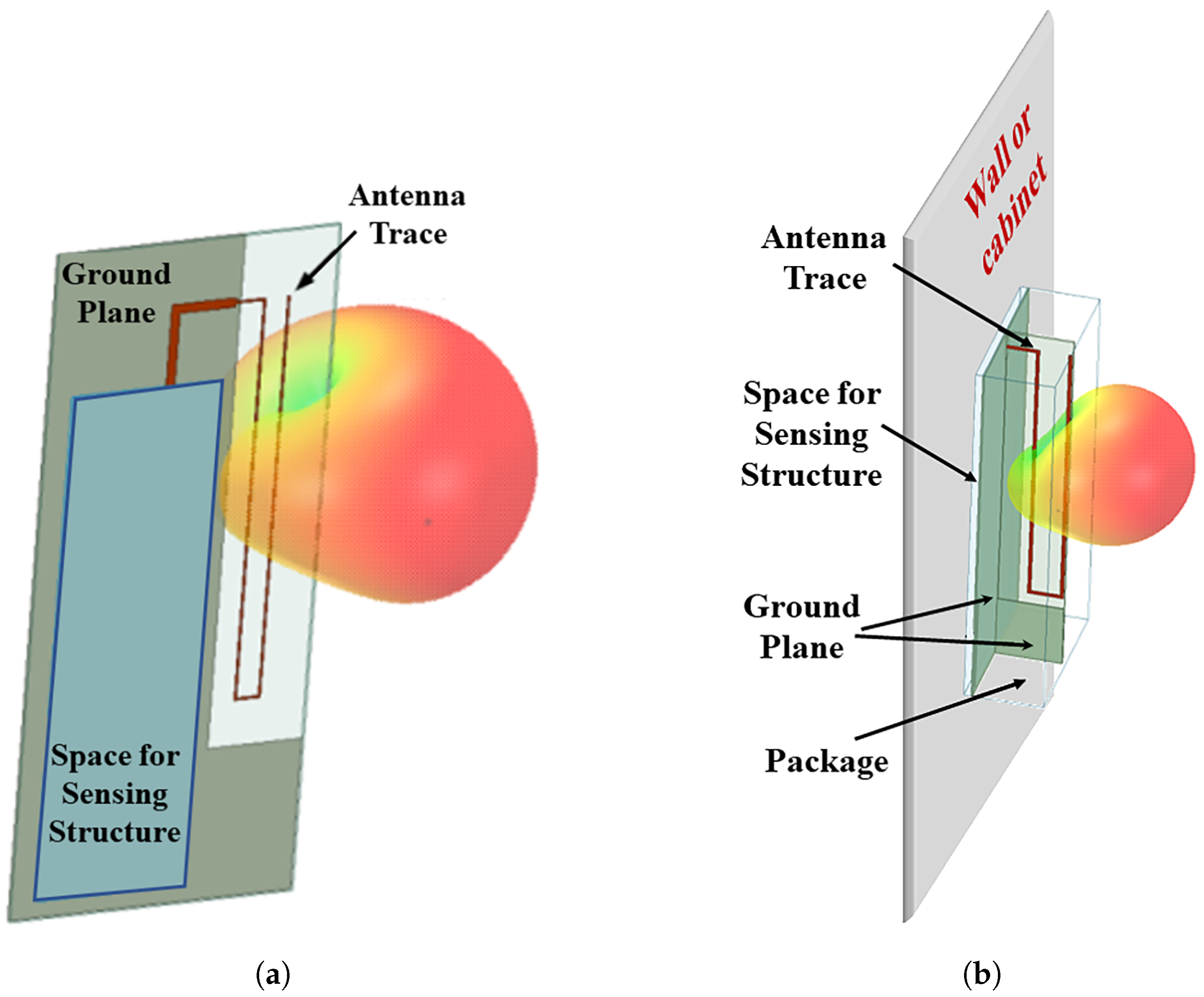
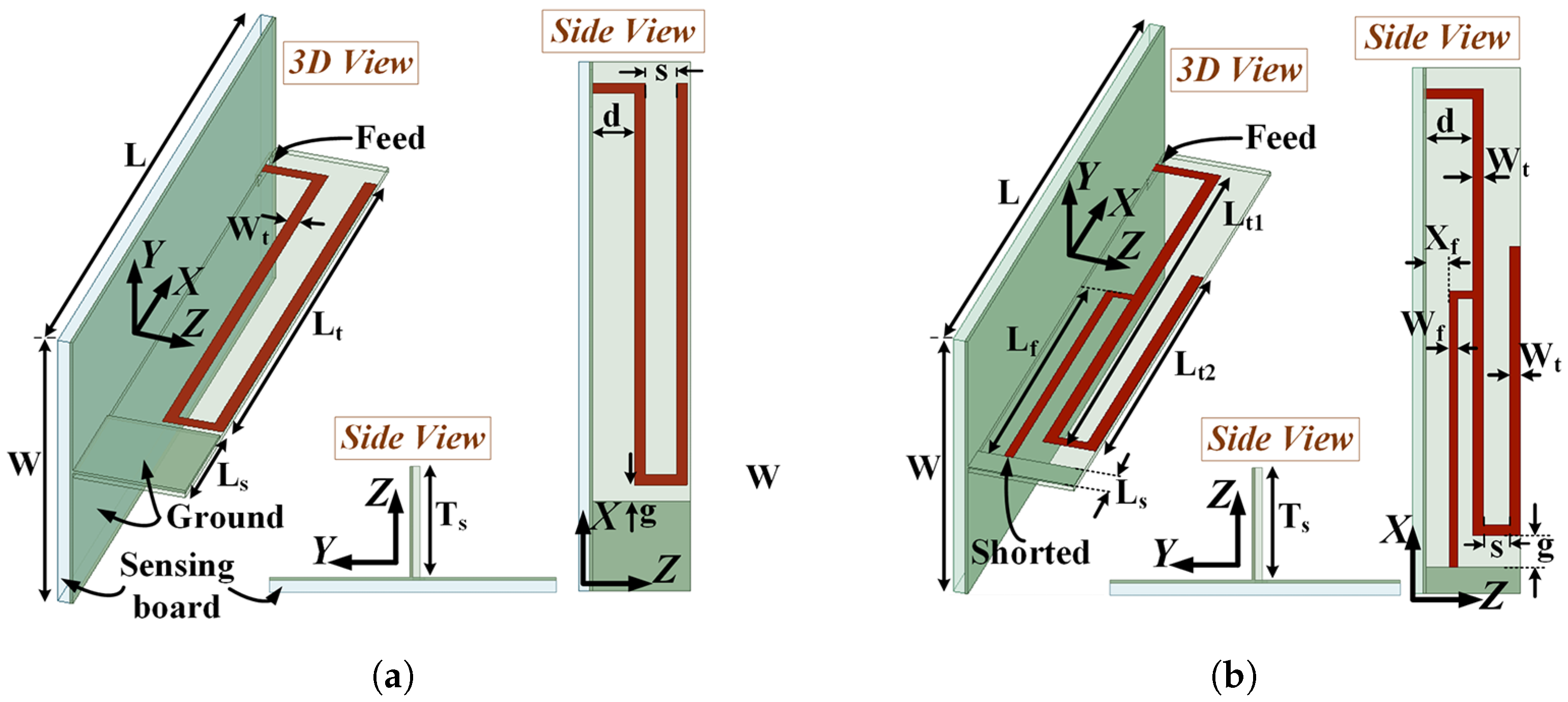
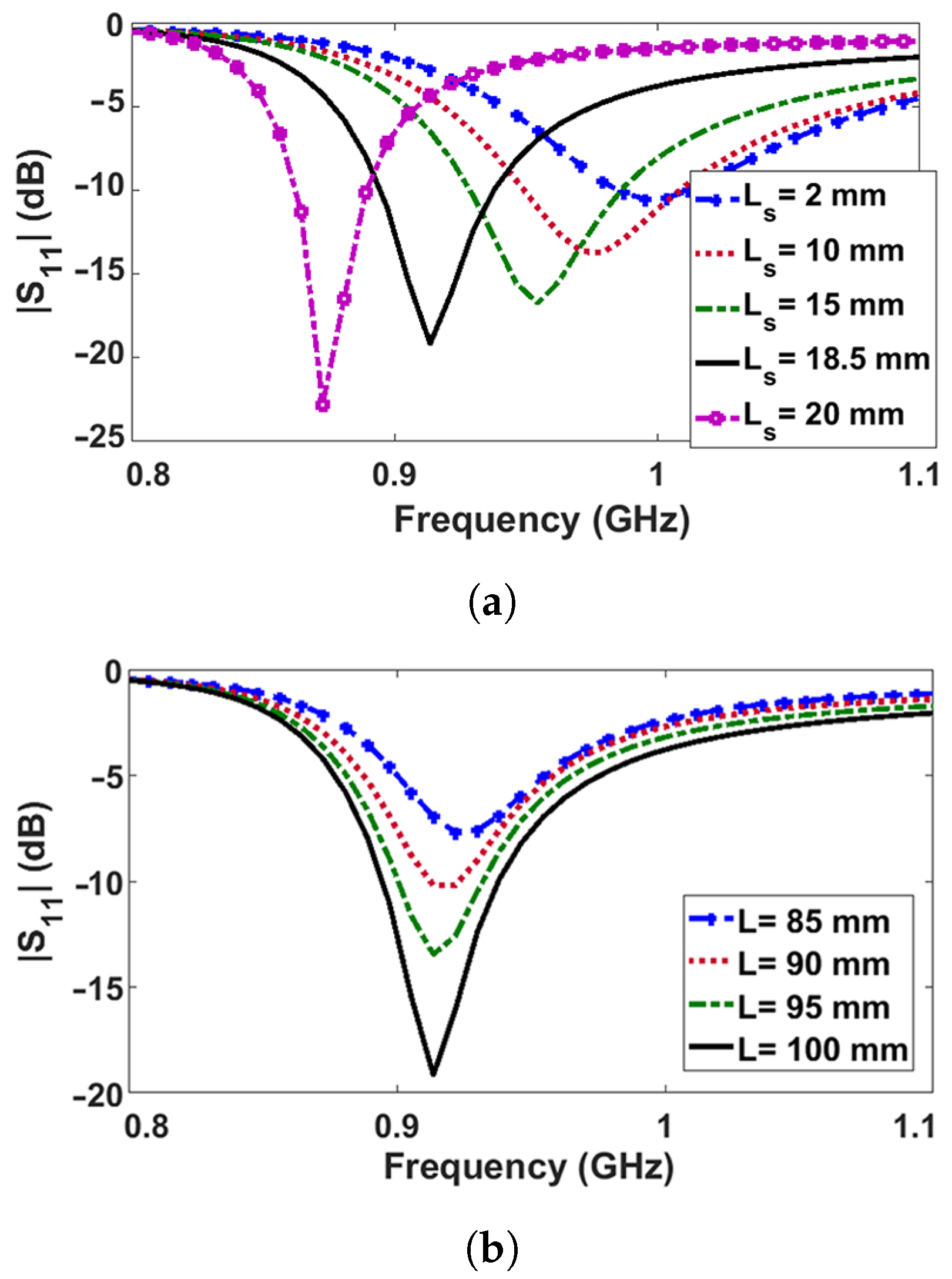
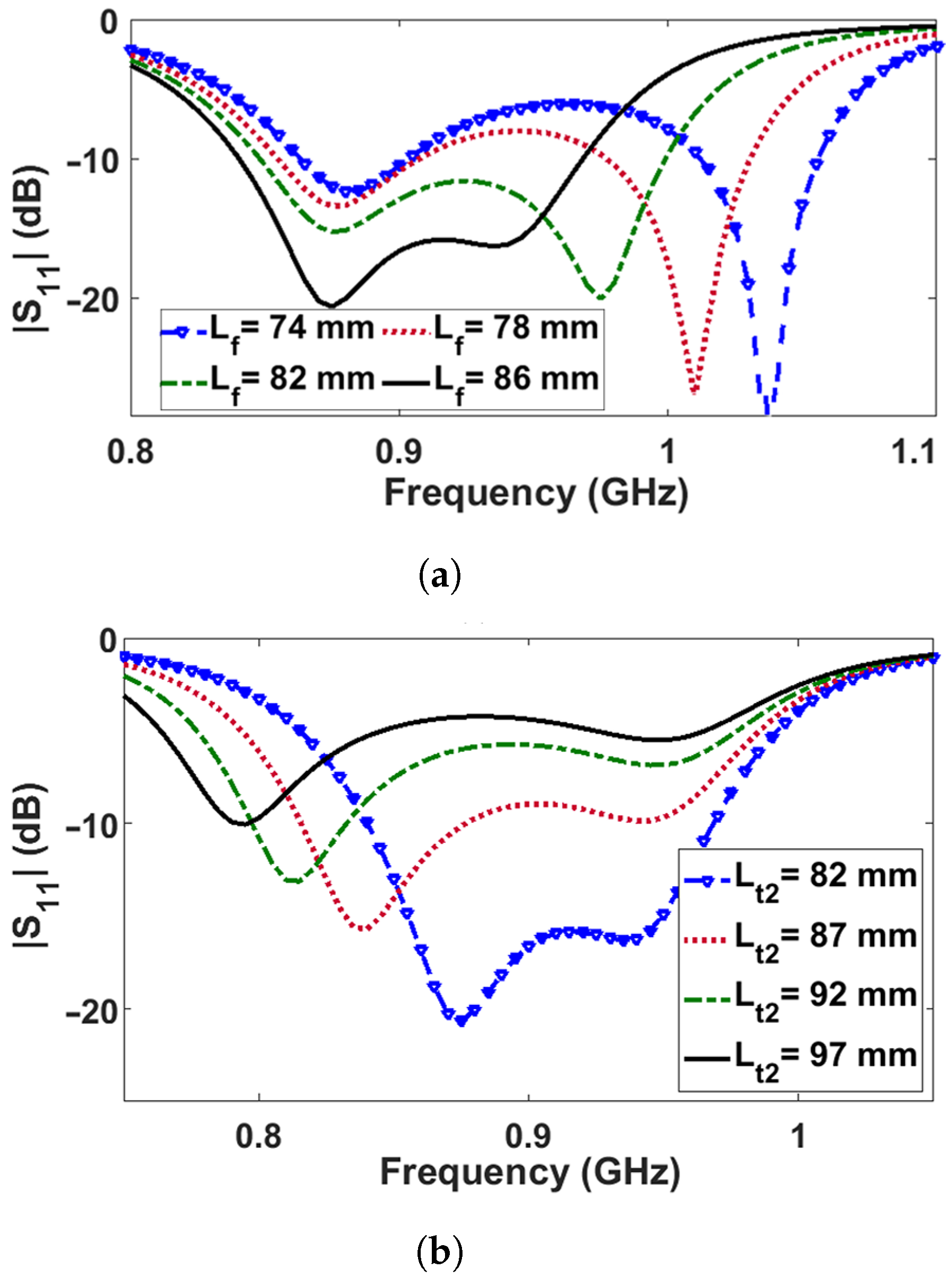
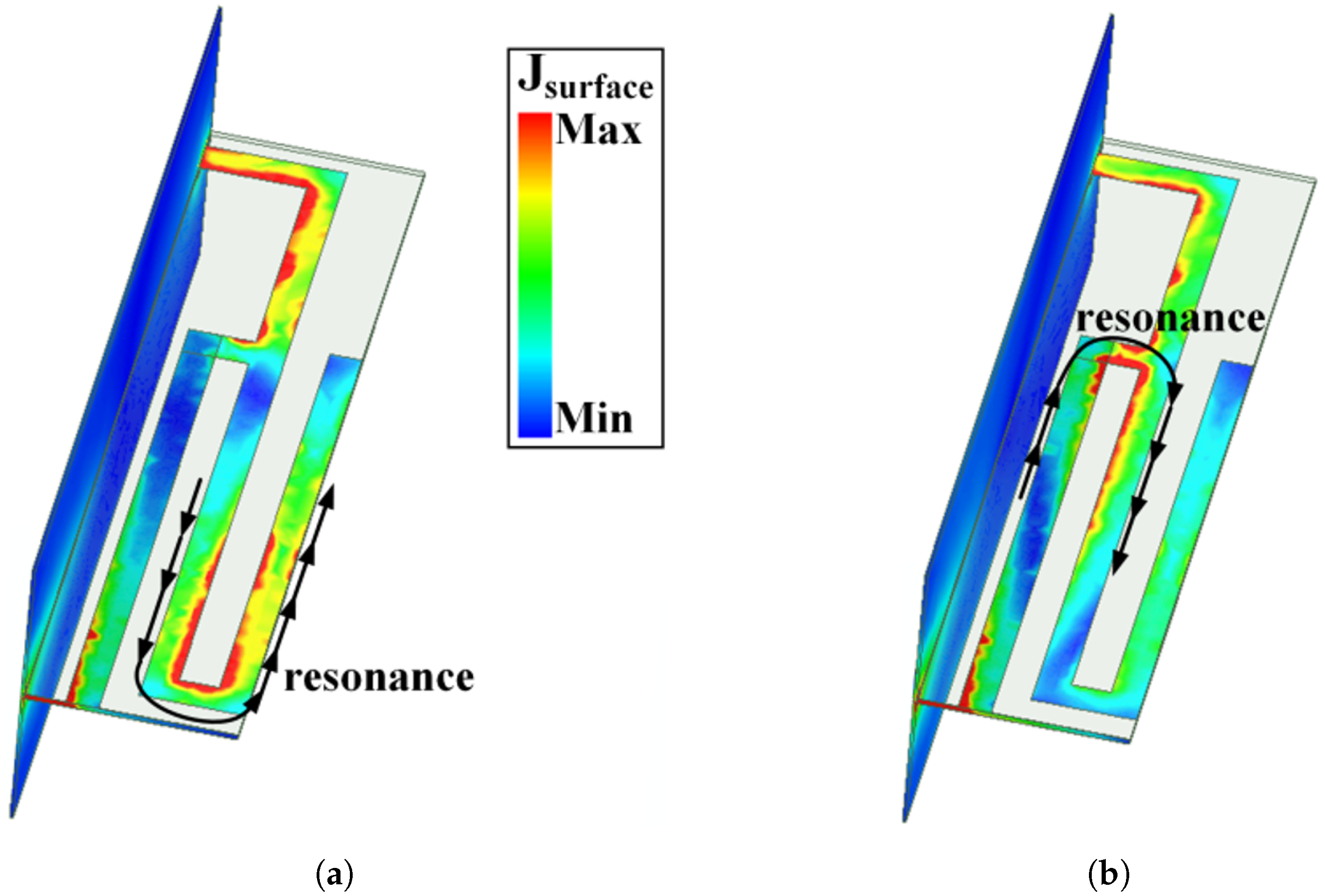

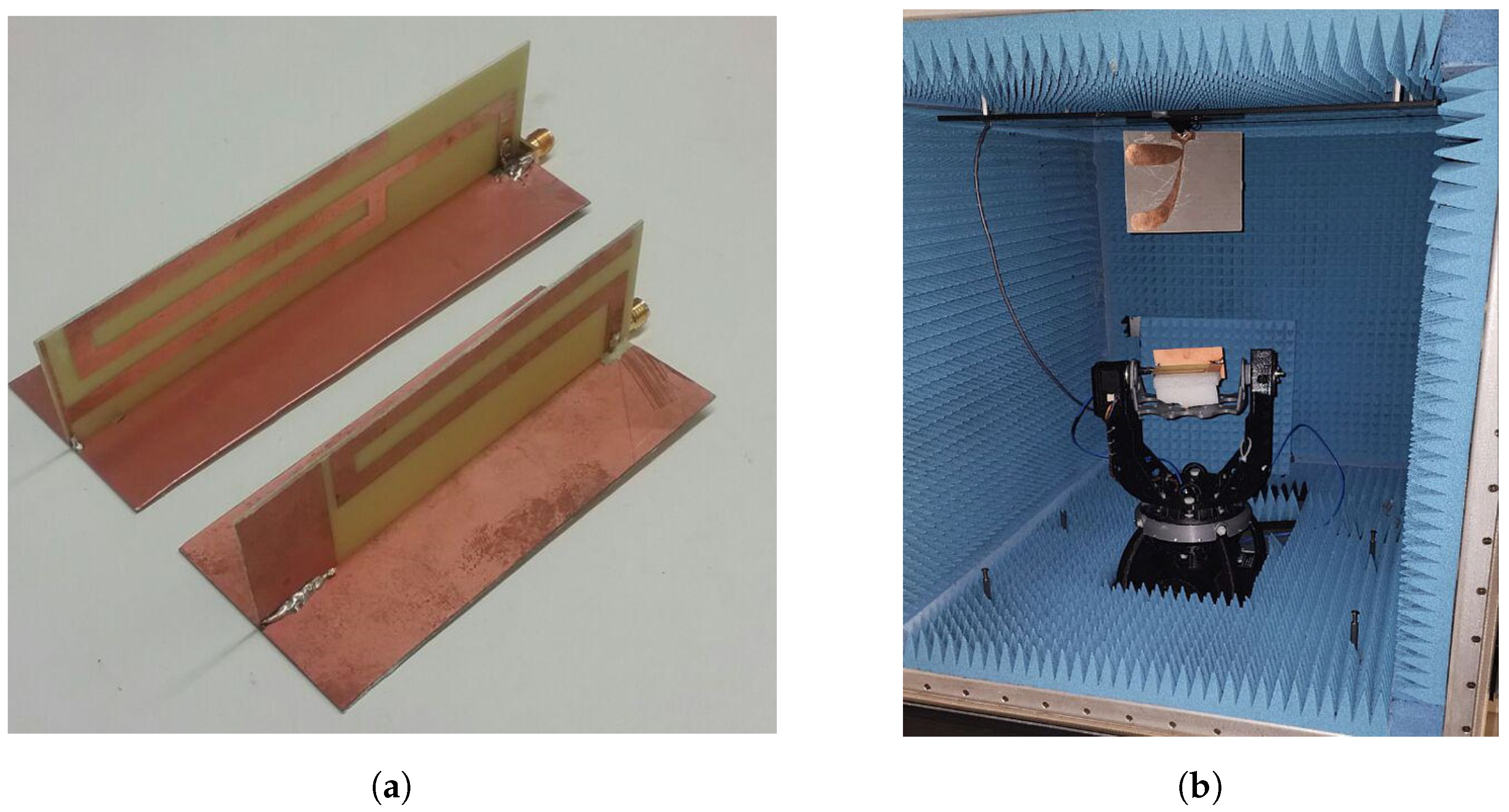


| References | Antenna Type | Antenna Size mm2 | Radiation Pattern | Radiation Efficiency (%) | Realized Gain (dBi) |
|---|---|---|---|---|---|
| our work | Monopole | 100 × 48 | Directional | 95 | 4 |
| [27] | Monopole | 83.625 × 83.625 | Directional | 76 | 2.7 |
| [28] | Monopole | 98.75 × 57 | Omnidirectional | N/A | 3.2 |
| [29] | Dipole | 101.2 × 10.5 | Omnidirectional | N/A | 3.14 |
| [30] | Patch | 50 × 50 | Directional | N/A | −5.4 |
Disclaimer/Publisher’s Note: The statements, opinions and data contained in all publications are solely those of the individual author(s) and contributor(s) and not of MDPI and/or the editor(s). MDPI and/or the editor(s) disclaim responsibility for any injury to people or property resulting from any ideas, methods, instructions or products referred to in the content. |
© 2024 by the authors. Licensee MDPI, Basel, Switzerland. This article is an open access article distributed under the terms and conditions of the Creative Commons Attribution (CC BY) license (https://creativecommons.org/licenses/by/4.0/).
Share and Cite
Honari, M.M.; Javadi, S.P.; Mirzavand, R. Folded Narrow-Band and Wide-Band Monopole Antennas with In-Plane and Vertical Grounds for Wireless Sensor Nodes in Smart Home IoT Applications. Electronics 2024, 13, 2262. https://doi.org/10.3390/electronics13122262
Honari MM, Javadi SP, Mirzavand R. Folded Narrow-Band and Wide-Band Monopole Antennas with In-Plane and Vertical Grounds for Wireless Sensor Nodes in Smart Home IoT Applications. Electronics. 2024; 13(12):2262. https://doi.org/10.3390/electronics13122262
Chicago/Turabian StyleHonari, Mohammad Mahdi, Seyed Parsa Javadi, and Rashid Mirzavand. 2024. "Folded Narrow-Band and Wide-Band Monopole Antennas with In-Plane and Vertical Grounds for Wireless Sensor Nodes in Smart Home IoT Applications" Electronics 13, no. 12: 2262. https://doi.org/10.3390/electronics13122262
APA StyleHonari, M. M., Javadi, S. P., & Mirzavand, R. (2024). Folded Narrow-Band and Wide-Band Monopole Antennas with In-Plane and Vertical Grounds for Wireless Sensor Nodes in Smart Home IoT Applications. Electronics, 13(12), 2262. https://doi.org/10.3390/electronics13122262










